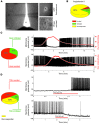Thyroid hormone is required for hypothalamic neurons regulating cardiovascular functions
- PMID: 23257356
- PMCID: PMC3533300
- DOI: 10.1172/JCI65252
Thyroid hormone is required for hypothalamic neurons regulating cardiovascular functions
Abstract
Thyroid hormone is well known for its profound direct effects on cardiovascular function and metabolism. Recent evidence, however, suggests that the hormone also regulates these systems indirectly through the central nervous system. While some of the molecular mechanisms underlying the hormone's central control of metabolism have been identified, its actions in the central cardiovascular control have remained enigmatic. Here, we describe a previously unknown population of parvalbuminergic neurons in the anterior hypothalamus that requires thyroid hormone receptor signaling for proper development. Specific stereotaxic ablation of these cells in the mouse resulted in hypertension and temperature-dependent tachycardia, indicating a role in the central autonomic control of blood pressure and heart rate. Moreover, the neurons exhibited intrinsic temperature sensitivity in patch-clamping experiments, providing a new connection between cardiovascular function and core temperature. Thus, the data identify what we believe to be a novel hypothalamic cell population potentially important for understanding hypertension and indicate developmental hypothyroidism as an epigenetic risk factor for cardiovascular disorders. Furthermore, the findings may be beneficial for treatment of the recently identified patients that have a mutation in thyroid hormone receptor α1.
Figures




Comment in
-
A heartfelt response: new thyroid hormone-sensitive neurons in the hypothalamus.J Clin Invest. 2013 Jan;123(1):117-20. doi: 10.1172/JCI67448. Epub 2012 Dec 21. J Clin Invest. 2013. PMID: 23257363 Free PMC article.
References
-
- Magnus-Levy A. Uber den respiratorischen Gaswechsel unter dem Einfluss der Thyroidea sowie unter verschiedenen pathologischen Zustanden. Berlin Klin Wochenschr. 1895;34:650–652.
Publication types
MeSH terms
Substances
LinkOut - more resources
Full Text Sources
Medical
Molecular Biology Databases

